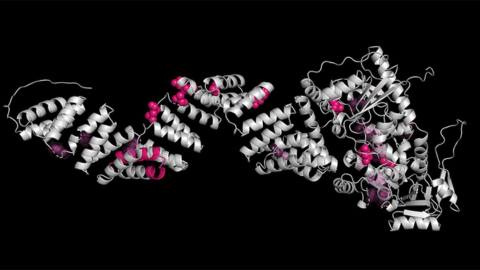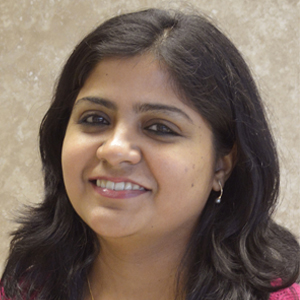InPrint offers opportunities to edit
I landed in St. Louis with a clear view of my goals and aspirations — to give undivided attention to my research and expand my viewpoint as a postdoctoral scientist. But I also had a side passion (albeit a major one) for scientific editing, and it turned out that my stint at Washington University has cultivated my editorial aspirations as well.

I always had loved working in a lab; troubleshooting experiments and analyzing data to understand the bigger picture gives me an adrenaline rush on a par with caffeine. However, when a grad school colleague approached me for help with her manuscript, I realized my passion for scientific editing. In the ten years since, I informally have edited countless manuscripts and articles for my friends and colleagues. Still wary of pursuing editing as a full-time career option, however, I chose to focus on a research-based career.
A month into my new job as a postdoc at WashU, I came across a universitywide call for editors for a trainee-run group called InPrint. Established just a few months earlier, InPrint then had eight members and was seeking to expand. I applied in a heartbeat and soon found myself among budding editors and science communicators.
InPrint was established in early 2018 with the goal of providing free and confidential editing services to the WashU community. I was ecstatic and hardly could believe my luck when I passed the editing test as part of my InPrint application. I had dabbled with freelance editing jobs in the past and was on the lookout for something more permanent to satiate my editing appetite. Cutting out extraneous words, restructuring sentences — that’s what I live for. My exchange visitor work visa did not allow me to pursue anything other than a postdoc in the United States. However, because it is associated with WashU and is volunteer work, I could join InPrint without jeopardizing my stay in the country.
During one of our monthly meetings, I was introduced to Deborah Frank, a full-time scientific editor in the department of obstetrics and gynecology at WashU who assists department members with grant and manuscript writing. I was excited to learn that scientific editing could be a full-time career choice in academia. Until then, I was only aware of a few private firms offering such services, companies that could be called midsized at best with a primarily English-as-a-second language clientele. For someone who wants to do copy editing, such companies are ideal. However, copy editing jobs offer few opportunities to develop the skills needed for a concept-based scientific editing career.
After a little digging into the academic science-communication job market, I found openings within WashU. In fact, the university has its own scientific editing core. As a graduate student from India, I had difficulty believing that, in the West, scientific editing had evolved into an academic career option. Given my visa status, I only could dream about applying for these jobs right at my doorstep. However, my association with InPrint gave me everything I was looking for — a platform to exercise and develop my editing skills and to network with people who shared my passion.
Any nonnative speaker pursuing a career as a scientist will tell you how challenging (and at times embarrassing) mastering English can be both in speaking and, especially, in writing. Grammar rules that come naturally to native English speakers can be hard for people like me to understand. As an avid reader, I’d been able to acquaint myself with the quirks of English grammar. However, interacting with peers from different ethnic backgrounds during our InPrint meetings and workshops gave me much-needed practice in applying these grammar rules to my spoken and written English language skills.
When InPrint receives an editing submission, the associate editor-in-chief assigns a first editor and a managing editor to the task. A two-week turnaround works for the majority of our clients, with a few requesting faster work. Our clients include faculty, postdocs, students and technicians.
Focusing only on editing does not do InPrint justice. Within a year of its formation, the group launched a parallel Schema Design service to help clients create graphics and scientific illustrations. By late 2020, this service boasted 30 clients in addition to 104 editing submissions since InPrint was founded.
Having no artistic aptitude, I was more attracted to writing for the InPrint blog. The group encourages each member to write about topics related to science communication, and we share these posts across all our social media handles. In addition to polishing writing skills, InPrint’s blog is an opportunity to build a writing portfolio. I wrote a blog post focused on little-known grammar rules that routinely confuse scientists during manuscript and grant writing.
InPrint now has 75 members including editors, schema designers and presentation consultants. In just three years, our editing and graphic contributions have crossed the century mark. We have numerous recurring clients, and several InPrint alumni now hold high-profile jobs, including editor with CellPress, industry scientist and university professor. We take immense pride in being the inspiration for a similar group —ReVision — at Johns Hopkins University.
For me, InPrint is the stepping stone to my long-term career goal of being a journal editor. My association with InPrint has given me confidence in my science communication skills and has prepared me for the job market. Most of our founding members have moved ahead in their career paths, while those of us still at InPrint hope the group will add to our past success in the years to come.
Enjoy reading ASBMB Today?
Become a member to receive the print edition four times a year and the digital edition monthly.
Learn moreFeatured jobs
from the ASBMB career center
Get the latest from ASBMB Today
Enter your email address, and we’ll send you a weekly email with recent articles, interviews and more.
Latest in Careers
Careers highlights or most popular articles

Upcoming opportunities
Coming soon: ASBMB Breakthroughs webinar on biosynthesis and regulation of plant phenolic compounds and a Lipid Research Division seminar on membrane lipids.

Upcoming opportunities
Just added: New fellowship and research award opportunities. Friendly reminder: Submit your abstract for ASBMB's upcoming meetings.

Upcoming opportunities
Friendly reminder: May 12 is the early registration and oral abstract deadline for ASBMB's meeting on O-GlcNAcylation in health and disease.

Sketching, scribbling and scicomm
Graduate student Ari Paiz describes how her love of science and art blend to make her an effective science communicator.

Embrace your neurodivergence and flourish in college
This guide offers practical advice on setting yourself up for success — learn how to leverage campus resources, work with professors and embrace your strengths.

Upcoming opportunities
Apply for the ASBMB Interactive Mentoring Activities for Grantsmanship Enhancement grant writing workshop by April 15.

